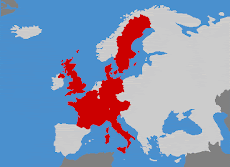.
How The Bible Came Together
 “Many professing Christians find the Bible a mysterious book filled with ancient writings that can seem of little relevance in our digital age, but our Creator is a God for every age and his purpose and goal for mankind has never changed.
“Many professing Christians find the Bible a mysterious book filled with ancient writings that can seem of little relevance in our digital age, but our Creator is a God for every age and his purpose and goal for mankind has never changed.
The modern western world is often referred to as a “post-Christian” society, with few being taught the Bible is the Word of God, and that we should be living by the instructions found within its pages (Matthew 4:4). As the Apostle Paul wrote to his fellow minister Timothy in 2 Timothy 3:16-17: “All Scripture is given by inspiration of God, and is profitable for doctrine, for reproof, for correction, for instruction in righteousness, that the man of God may be complete, thoroughly equipped for every good work.”
It is important to have a general knowledge of how the books of the Holy Bible came together and to be assured that the canon–the group or list of books that are considered to be inspired by God–are inspired by God and contain the books that it should.
The books of the Bible (originally on scrolls) were written by various historians, priests, prophets and kings over a period of at least 1600 years. Their writings cover events such as the Creation and Flood; the histories of Israel, Judah and their respective kings; God’s rules and regulations for living healthy and fulfilling lives, instructions on how to strengthen our relationships with God and our fellow man; and prophecies concerning the future salvation of the vast majority of human beings through Jesus Christ.
Chapter breaks were only added in the thirteenth century and verses in the sixteenth century. These additions sometimes do marginal damage to the text, for example a chapter break can occur in the middle of an account, but have the great advantage of making it easier to find various passages quickly.
The books of the Old and New Testaments were written and canonized beginning in the 15th century BC with the Pentateuch (the first five books of the Bible) and finishing near the end of the first century after Christ with the book of Revelation. No historian has left an account of the steps taken in this long process. However, we do have titbits of information here and there that give us some knowledge regarding what took place.
The Old Testament or Hebrew Bible
Over the thousand years during which it was written, the Old Testament underwent at least five periods of canonization. Ezra, a priest and scribe, apparently was the one responsible for the final collection and arrangement of the books of the Hebrew Bible (what we call the Old Testament) around 450 B.C. With this canonization the Old Testament was essentially complete.
Jesus Christ affirmed His acceptance of the three divisions of the Old Testament – Law, Prophets and Writings (or Psalms after its first and largest book) – as canonical. Notice His statement in Luke 24:44: “These are the words which I spoke to you while I was still with you, that all things must be fulfilled which were written in the Law of Moses and the Prophets and the Psalms concerning Me.”
The New Testament
No one is certain how the New Testament canon came together. In A.D. 397 the Synod of Carthage confirmed as canonical the 27 books of our New Testament, but it really only recognized that these books had been in use and read in the churches for some three centuries.
One theory maintains that the Apostles Paul, Peter and John were the final canonizers of the New Testament and that John, with the help of other believers, was able to finalize and distribute copies of the entire 27 books to the churches in Asia Minor and the Holy Land.
This view is supported by several New Testament passages. Peter, writing to the early Church, commented that he considered the letters of Paul part of the “Scriptures” (2 Peter 3:15-16), putting the writings of the Apostle Paul on an equal footing with the Old Testament Scriptures. This indicates that the Apostles already considered some of their writings to be divinely inspired and deserving of inclusion in the canon of Holy Scripture.
Paul appears to have helped in selecting which books and letters, particularly of his writings, were to be preserved for us. In 2 Timothy 4:13 he asks Timothy to “Bring the cloak that I left with Carpus at Troas when you come – and the books, especially the parchments.” This is a puzzling request, unless Paul was asking Timothy to bring books and letters from which he would select those that would be part of the canon.
Some of his letters, such as the one to the church in Laodicea mentioned in Colossians 4:16, were not preserved. Presumably those Paul chose were then passed on to other Apostles. It seems most likely that the Apostle John, who outlived all the other apostles, under God’s inspiration made the final selections of the writings that would be included as Scripture in what we know as the New Testament.
In the final chapter of the final book of the Bible, John gives a warning that appears to indicate that the Bible was then complete with nothing more to be added or taken away. “If anyone adds to these things, God will add to him the plagues that are written in this book; and if anyone takes away from the words of the book of this prophecy, God shall take away his part from the Book of Life, from the holy city, and from the things which are written in this book” (Revelation 22:18-19).
Which Bible translation is best?
More than 60 English-language versions of the Bible are available. Scholars divide them into three broad types: word-for-word, meaning-to-meaning (also called thought-for-thought) and paraphrased. Usually a particular Bible version will explain, on its introductory pages, which approach was used in preparing it. Word-for-word versions most accurately follow the Hebrew, Aramaic and Greek texts.
Generally speaking, the King James Version and its modern counterpart, the New King James Version, are word-for-word translations. Meaning-to-meaning versions, such as the New International Version (NIV) can be valuable in putting the Scriptures into more understandable wording. The Revised English Bible, Good News Bible and New Living Translation are other popular meaning-to-meaning translations.
Paraphrased Bibles, such as The Living Bible or The Message, can also be useful. Their goal is to make the Bible even easier to read in modern language. However, caution is needed when working with these, because the authors exercised considerable “poetic license” in interpreting biblical terms and passages according to their own personal religious ideas. Paraphrased versions can be consulted to better grasp the story flow, but should not be relied upon exclusively to establish doctrine or for accurately determining the meaning of any text.
Many Bible versions are now also available as part of Bible software packages or for free viewing on various Internet sites, enabling the reader to compare different versions nearly instantaneously. With the Word of God so freely available, the most important factor is that we actually read it and learn to live by it.” From: https://ucg.org.uk/wp-content/uploads/2019/07/Supplement-MayJune-2019.pdf
_______
 'The Death of Jezebel' by Gustave Doré
'The Death of Jezebel' by Gustave Doré














